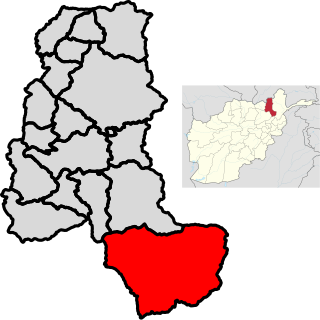Related Research Articles

Badakhshan Province is one of the 34 provinces of Afghanistan, located in the northeastern part of the country. It is bordered by Tajikistan's Gorno-Badakhshan in the north and the Pakistani regions of Lower and Upper Chitral and Gilgit-Baltistan in the southeast. It also has a 91-kilometer (57-mile) border with China in the east.
The Pamir languages are an areal group of the Eastern Iranian languages, spoken by numerous people in the Pamir Mountains, primarily along the Panj River and its tributaries.

The Panjshir Valley is a valley in northeastern Afghanistan, 150 kilometres (93 mi) north of Kabul, near the Hindu Kush mountain range. It is divided by the Panjshir River. The valley is home to more than 100,000 people, including Afghanistan's largest concentration of ethnic Tajiks as of 1997. In April 2004, it became the heart of the new Panjshir Province, having previously been part of Parwan Province. Politically, this province has been considered the start point of Afghanistan's Jihad period against the Soviets. This province is also the birthplace of Afghanistan's national hero, Ahmad Shah Massoud.

The Yidgha language is an Eastern Iranian language of the Pamir group spoken in the upper Lotkoh Valley of Chitral in the Khyber Pakhtunkhwa province of Pakistan. Yidgha is similar to the Munji language spoken on the Afghan side of the border.

The Munji language, also known as Munjani, Munjhan (مونجهان), and the Munjiwar language, is a Pamir language spoken in the Munjan valley in the Kuran wa Munjan district of the Badakhshan province in northeast Afghanistan. It is similar to the Yidgha language, which is spoken in the Upper Lotkoh Valley of Chitral, west of Garam Chashma in Khyber Pakhtunkhwa, Pakistan.

Nadia Anjuman was a poet from Afghanistan.

Kuran wa Munjan is one of the 28 districts of Badakhshan province in eastern Afghanistan. Located in the Hindu Kush mountains, the district is home to approximately 8,000 residents. The district administrative center is Kuran wa Munjan.

The Panjshir River flows through the Panjshir Valley in northeastern Afghanistan, 150 kilometres (93 mi) north of Kabul. Its main tributary is the Ghorband River which flows from the Parwan Province and joins the Panjshir River 10 km east of Charikar in Bagram District. The Panjshir River takes its source near the Anjuman Pass and flows southward through the Hindu Kush and joins the Kabul River at Surobi. A dam was built on the Panjshir River near Surobi in the 1950s to supply water from the Panjshir River to the Kabul River. There is just one permanent bridge on the Panjshir River that provides access to the Bagram Airport. On 12 July 2018, a flood in Panjshir Valley killed ten people.

Warsaj District is a district of Takhar Province, northern Afghanistan.
Anjum, Anjom, Anjuman or Anjoman, meaning a gathering or society, may refer to:
Darmarakh is a village in Badakhshan Province in north-eastern Afghanistan. Around the turn of the 20th century, there was a village of this name consisting of seven houses, in the Darmarakh valley, located on the right side of the stream running through the valley. Some five miles upstream of the village was another village, Darmarokh Bala. During the winters, when the Ghar Jabin pass became inaccessible due to the snow, this valley was used as an alternate patah for communications in emergencies.
Eskan is a village in Badakhshan Province in north-eastern Afghanistan. It is located in the valley of the Munjan, about 18 miles upstream of Jurm. Around the turn of the 20th century it had been a village of roughly 40 houses.
Ghar Javin is the name of a mountain pass and of a nearby village in Badakhshan Province in north-eastern Afghanistan. The valley contains three villages of the same time. Nearby is the direct road from Bar Panja, located some miles downstream, and Badakhshan. The village is located about four miles north of the pass.

The Kokcha River is located in northeastern Afghanistan. A tributary of the Panj river, it flows through Badakhshan Province in the Hindu Kush. It is named after the Koksha Valley. The city of Feyzabad lies along the Kokcha. Near the village of Artin Jelow there is a bridge over the river.
Anjuman, also written Anjoman, is the name of a village in Badakhshan Province, Afghanistan. It lies within the Anjuman Valley, about 18 miles from the mouth of the valley. Another village, Anjuman-i-Khurd, lies close by. Around the turn of the 21st century, the village had 90 occupied residences, primarily Tajiks. The grazing in the area was good, and the inhabitants were a peaceful lot, and relatively poorly armed.
Anjuman-i-Khurd is a village in Afghanistan. It lies within the Anjuman Valley, about 18 miles from the mouth of the valley. Another village, Anjuman, lies close by. Around the turn of the 20th century, the village had 30 occupied residences, primarily Tajiks. The grazing in the area was good, and the inhabitants were a peaceful lot, and relatively poorly armed. Khurd and Kalan Persian language word which means small and Big respectively when two villages have same name then it is distinguished as Kalan means Big and Khurd means Small with Village Name.
The Anjuman Pass is a mountain pass in the Hindu Kush in Afghanistan. It connects the Panjshir Valley and beyond in the south-west with Badakhshan province and beyond to the north-east, which is the most north-easterly province of Afghanistan. The Anjuman Pass is located on Panjshir Province's border with Badakhshan and Takhar province. The climate in this area is usually cold with snow. The roads are narrow and slippery.

Bargi Matal District is a district of Nuristan Province, Afghanistan. It was originally in Konarha Province and then was moved to the newly created Nuristan Province in 2001.
The Yidgha-Munji people also known as Mukhbani are the Iranian-Pamiri peoples inhabiting the Lotkoh Valley in Chitral and Kuran wa Munjan District in Badakhshan in both Pakistan and Afghanistan.
Koksha is a valley that is located in Badakhshan's Kuran Wa Munjan District in Afghanistan. Koksha is famous for its lapis lazuli found in the mines of Sar-e-Sang since the 3rd millennium BC. Koksha Valley includes Mount Ladjuar. The main river is the Koksha River, the tributary in the valley. Parts of the valley are also found in Jurm District.
References
- 1 2 3 Adamec, Ludwig W., ed. (1972). Historical and Political Gazetteer of Afghanistan. Vol. 1. Graz, Austria: Akadamische Druck-u. Verlangsanstalt. p. 21.